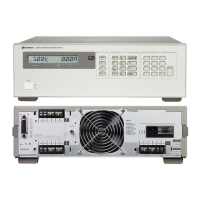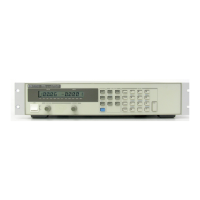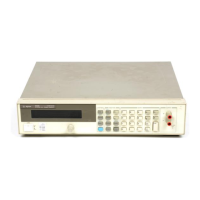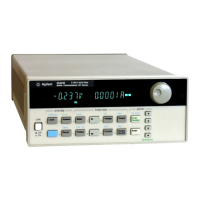impedance state when CS3 is not decoded.
2-18 Data Latches. These stages (U213) are edge-triggered
D-type flip-flops. On the rising edge of the CS2 chip select,
the output of each stage will be set to the logic state that is
present on the associated data bus line. Data bus line D0-D3
are the serial data input lines for output boards 1-4,
respectively. Data bus line D4 controls the TIMER ENABLE
signal line to the real time clock circuit; D5 is the chip select
line for the EEPROM; D6 is the clock signal for the
EEPROM; and D7 is the data input line for the EEPROM.
The data that is transferred between the GPIB board and
the output boards (up to 4) passes through optical isolators
located on each output board.
2-19 EEPROM. This 4 K bit serial EEPROM (electrically
erasable programmable memory) stores the power supply’s
GPIB address and model number as well as the constants
used in calibrating the supply. The EEPROM (U230) is
nonvolatile allowing it to retain the stored information after
power is cycled off and on.
Because the RAM operates faster than the EEPROM, at
power on, the stored data is read into RAM in the system
microcomputer via data bus line D7.
The EEPROM’s 4096 bits of read/write memory are divided
into 2 pages of 8 X 256 each. Each register can be serially
read from or written to using data bus line D7. Input data is
received via a data latch and output data is sent via a data
buffer.
Data written to the EEPROM is stored in a location until it is
updated by a write cycle. The CHIP SELECT and CLOCK
signals are use by the microprocessor to control the
EEPROM’s programming modes. AT power on, the
EEPROM signal holds the EEPROM’s CLOCK signal off to
protect against accidental data writes when power is initially
applied.
2-20 Front Panel Interface
These circuits provide the interface between the supply’s
system microcomputer and the front panes (keyboard and
LCD display). The microprocessor uses the data latches
(U210 ) and data buffers (U214) to transfer data between the
supply’s system microcomputer and the front panel.
2-21 Data Latches. On the rising edge of the CS5 chip select
these D-type flip-flops will be set to the logic states that are
present on the data bus lines.
Data bus line D0-D2 are fed to the 3 to 8 line keyboard
decoder (U211). The microprocessor successively drives
each of the eight open collector outputs of the decoder and
monitors the four readback lines from the keyboard to
determine which key was pressed. The readback lines are
held high until a depressed key pulls the line low.
2-22 Data Buffers. These 3-state buffers place the keyboard
readback data on data bus lines D4-D7 when chip select CS4
is decoded. As stated above, the microprocessor will use this
information to determine which key was pressed. In
addition buffers provide the following data on bus lines D0-
D3 when CS4 is decoded:
D0 - A logic 1 (Jumper W201 is not installed in the
Skip Self Test position) – tells the
microprocessor to perform the self test at
power on;
or
a logic 0 (Jumper W201 is installed in the Skip
Self Test position) – tells the microprocessor
not to perform self test at power on.
D1 - A logic 1 (Jumper W201 is not installed in the
Cal Lockout position) – tells the
microprocessor to respond to calibration
commands;
or
a logic 0 (Jumper W201 is installed in the Cal
Lockout position ) – tells the microprocessor
to ignore calibration commands. This jumper
provides security against unauthorized
calibration.
D2 - A logic 0 indicates Remote Inhibit is true
(OPTION 750).
D3 - A logic 1 indicates OPTION 750 is installed in
power supply.
All buffer outputs are held in the high impedance state
disconnecting it from the data bus when CS4
is not decoded.
2-23 Bias Supply and Start-Up Circuit
The bias supply (U218) provides + 5 V bias power to operate
the circuits on the GPIB board. The start-up circuit (U220,
U222) generates the OPTO PON signal (delayed +5 V) which
is used to power the optical-isolators on the output boards.
The OPTO PON signal is initially held low for
approximately 100 ms to prevent the erroneous transfer of
data at power on. The start-up circuit also generates PCLR
(power clear) and EEPON (EEPROM power on) signals
when power is turned on. The PCLR signal is held low at
power on to initialize the talker/listener and microprocessor
chips. The EEPON signal is held low at power onto disable
the EEPROM clock. Thus, the start up circuit delays turning
on the microprocessor and optoisolators until the bias
voltages have stabilized. If the line voltage drops after the
unit has been turned on, the start-up circuit will again
generate the low level signals to disable the interface and
remove power from the supply’s outputs.
2-5
__
_
__
_
___________
__
_
__
_
__
_
__
_
__
_
__
_
__
_
__
_
serial output data appears on data bus line D7. Logic 0’s will
always appear on data bus lines D4-D6 when CS3 is
decoded because these buffer inputs are connected to
COMMON. All buffer output are held in the high
__
_
Data bus lines D2-D7 are fed directly to the front panel
display to indicate power supply conditions The LCD
display may indicate the output voltage and current for a
selected output board, the present function being
programmed, a programmed message, or an error message.
The annunciators provide operating and status information.
The microprocessor uses the real time clock to determine
when update/refresh the display.
Artisan Scientific - Quality Instrumentation ... Guaranteed | (888) 88-SOURCE | www.artisan-scientific.com

